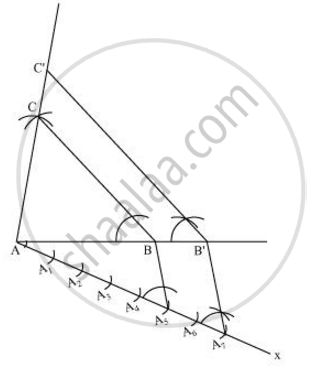Advertisements
Advertisements
प्रश्न
Construct a triangle with sides 5 cm, 6 cm and 7 cm and then another triangle whose sides are `7/5` of the corresponding sides of the first triangle. Give the justification of the construction.
उत्तर १
Step 1
Draw a line segment AB of 5 cm. Taking A and B as centre, draw arcs of 6 cm and 7 cm radius respectively. Let these arcs intersect each other at point C. ΔABC is the required triangle having length of sides as 5 cm, 6 cm, and 7 cm respectively.
Step 2
Draw a ray AX making acute angle with line AB on the opposite side of vertex C.
Step 3
Locate 7 points, A1, A2, A3, A4 A5, A6, A7 (as 7 is greater between 5and 7), on line AX such that AA1 = A1A2 = A2A3 = A3A4 = A4A5 = A5A6 = A6A7.
Step 4
Join BA5 and draw a line through A7 parallel to BA5 to intersect extended line segment AB at point B'.
Step 5
Draw a line through B' parallel to BC intersecting the extended line segment AC at C'. ΔAB'C' is the required triangle.

Justification
The construction can be justified by proving that
AB' = 7/5AB, B'C' = 7/5(BC), AC'=7/5 (AC)
In ΔABC and ΔAB'C',
∠ABC = ∠AB'C' (Corresponding angles)
∠BAC = ∠B'AC' (Common)
∴ ΔABC ∼ ΔAB'C' (AA similarity criterion)
`=> (AB)/(AB')=(BC)/(B'C')=(AC)/(AC') ....(1)`
In ΔAA5B and ΔAA7B',
∠A5AB = ∠A7AB' (Common)
∠AA5B = ∠AA7B' (Corresponding angles)
∴ ΔAA5B ∼ ΔAA7B' (AA similarity criterion)
`=> (AB)/(AB') = (`
`=>(AB)/(AB')=5/7 ....(2)`
On comparing equations (1) and (2), we obtain
`(AB)/(AB')=(BC)/(B'C') = (AC)/(AC') = 5/7`
`=>AB' = 7/5 AB, B'C' = 7/5 BC, AC' = 7/5 AC`
This justifies the construction.
उत्तर २
Given that
Construct a triangle of sides AB = 5cm, BC = 6cm and AC = 7cm and then a triangle similar to it whose sides are 7/5th of the corresponding sides of ΔABC .
We follow the following steps to construct the given

Step of construction
Step: I- First of all we draw a line segment AB = 5cm.
Step: II- With A as centre and radius AC = 7cm, draw an arc.
Step: III- With B as centre and radius = BC = 6cm, draw an arc, intersecting the arc drawn in step II at C.
Step: IV- Joins AC and BC to obtain ΔABC.
Step: V- Below AB, makes an acute angle ∠BAX = 60°.
Step: VI- Along AX, mark off seven points A1, A2, A3, A4, A5, A6 and A7 such that AA1 = A1A2 = A2A3 = A3A4 = A4A5 = A5A6 = A6A7
Step: VII-Join A5B.
Step: VIII- Since we have to construct a triangle each of whose sides is 7/5th of the corresponding sides of ΔABC.
So, we draw a line A3B' on AX from point A7 which is A7B' || A5B and meeting AB at B'.
Step: IX- From B' point draw B'C' || BC, and meeting ACat C'
Thus, ΔAB'C' is the required triangle, each of whose sides is 7/5th of the corresponding sides of ΔABC.
संबंधित प्रश्न
Draw a triangle ABC with BC = 7 cm, ∠B = 45° and ∠A = 105°. Then construct a triangle whose sides are`4/5` times the corresponding sides of ΔABC.
Divide a line segment of length 9 cm internally in the ratio 4 : 3. Also, give justification of the construction.
Draw a right triangle ABC in which AC = AB = 4.5 cm and ∠A = 90°. Draw a triangle similar to ΔABC with its sides equal to (5/4)th of the corresponding sides of ΔABC.
Draw a ∆ABC in which AB = 4 cm, BC = 5 cm and AC = 6 cm. Then construct another triangle whose sides are\[\frac{3}{5}\] of the corresponding sides of ∆ABC ?
Draw seg AB of length 9.7 cm. Take a point P on it such that A-P-B, AP = 3.5 cm. Construct a line MN ⊥ sag AB through point P.
Choose the correct alternative:
∆ABC ∼ ∆AQR. `"AB"/"AQ" = 7/5`, then which of the following option is true?
ΔPQR ~ ΔABC. In ΔPQR, PQ = 3.6cm, QR = 4 cm, PR = 4.2 cm. Ratio of the corresponding sides of triangle is 3 : 4, then construct ΔPQR and ΔABC
ΔABC ~ ΔPBR, BC = 8 cm, AC = 10 cm , ∠B = 90°, `"BC"/"BR" = 5/4` then construct ∆ABC and ΔPBR
The basic principle used in dividing a line segment is ______.
Draw a line segment AB of length 6 cm and mark a point X on it such that AX = `4/5` AB. [Use a scale and compass]
